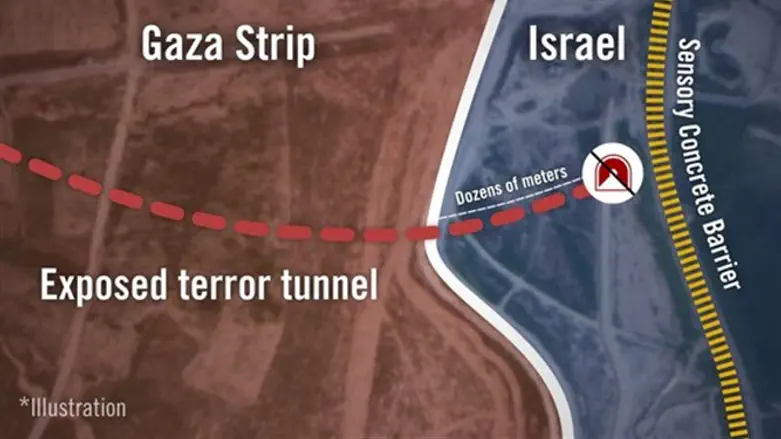
Stephen M. Flatow is a vice president of the Religious Zionists of America, an attorney in New Jersey and the father of Alisa Flatow, who was murdered in an Iranian-sponsored Palestinian terrorist attack in 1995. He is the author of “A Father’s Story: My Fight for Justice Against Iranian Terror.” He resides in Jerusalem.
From the view of my Jerusalem balcony, it seems like Israel is at peace. But looking a little closer, you realize that is not the case. Developments on all three of Israel’s frontiers in recent days remind us of the low-level warfare that Arab forces are continuing to wage—and the hazards of making the concessions that Israel’s critics are always demanding.
In the south, the Israeli army uncovered yet another “terror tunnel” stretching from the Gaza city of Khan Younis into Israeli territory. Just because the tunnels are not in the headlines any more, doesn’t mean they’re not there. Israel has destroyed or sealed dozens of them over the years; but Hamas keeps building more.
Whenever I think about the tunnels, I am reminded of the incredible “ mea culpa” that former U.S. State Department peace processor Dennis Ross wrote about in the Washington Post a few years back. He recalled how when Hamas was in the early phase of tunnel-building, the Israelis began restricting the importation to Gaza of building materials that could be used for that purpose. So, the Obama administration sent Ross to the region--to pressure Israel.
Ross later wrote: "I argued with Israeli leaders and security officials, telling them they needed to allow more construction materials, including cement, into Gaza so that housing, schools and basic infrastructure could be built. They countered that Hamas would misuse it, and they were right.”
Assured by the Obama administration's insistence that the cement would not be used for military purposes, Israel allowed it to be imported. The result? Hamas built "a labyrinth of underground tunnels, bunkers, command posts and shelters for its leaders, fighters and rockets," Ross acknowledged. They built them with "an estimated 600,000 tons of cement," some of which was "diverted from construction materials allowed into Gaza."
I wonder if the recently-discovered Khan Younis tunnel was built with any of the tons of concrete that entered Gaza, thanks to Ross’s pressure. Ross may think that if he writes one article admitting an error, that all is forgiven—but the Israelis who are in Hamas’s line of fire will have to live with the consequences of his errors for years to come.
Meanwhile, on Israel’s eastern front, a Palestinian Arab who tried to stone Jews to death ended up dead himself. As is typical, the Palestinian Authority is circulating outlandish claims, accusing Israeli forces of bludgeoning the rock-thrower to death.
What we know is that the terrorist, whose name was Amer Snobar, left his home town of Yatma and drove with a friend to a spot near the village of Turmus Aya, where they hurled rocks at passing Israeli vehicles, in the hope that they would cause the cars to spin out of control and crash. Since the PA considers throwing rocks at Jews to be legitimate and non-violent, any Israeli action against Arab rock-throwers is regarded by the PA as murder.
It’s interesting to note that Yatma and Turmus Aya are both governed by the PA. Israel’s critics claim that Arab rock-throwers are understandably “resisting” the “occupation.” But Israel stopped occupying Yatma and Turmus Aya back in 1995. There are no Israeli “occupiers” in town to murder. So Snobar and his fellow terrorist had to leave PA territory in order to pursue their deadly goal.
Imagine what would have happened if the PA territories were turned into a sovereign state, as so many people are demanding. Snobar and his comrade could have stoned some Jews and then fled into “Palestine” for protection. The Israeli army would have been helpless to pursue them across an internationally-recognized border.
On Israel’s northern front last week, the army was conducted a large-scale exercise simulating war. The expected enemy was not Syria or Lebanon, but rather Hezbollah, which has transformed itself in recent years from a ragtag terrorist group into a full-scale army.
With Iranian backing, Hezbollah has amassed an estimated 150,000 missiles along the Israel-Lebanon border. Israelis are taking the threat seriously. The exercises involved both regular troops and reservists, “alongside the air force, navy and ground forces, as well as the intelligence, technology and logistics, teleprocessing and cyber defense directorates,” an army spokesman said.
Israel halted its 2006 action against Hezbollah in response to international criticism and promises by the United Nations Security Council to keep southern Lebanon out of the terrorists’ control. Of course, those promises were never kept, and now the danger is many times what it was then.
Notice the recurring theme: Israel defends itself, the world howls in protest, Israel retreats in exchange for promises, and the promises are quietly shelved. How long will this outrageous cycle repeat itself?
